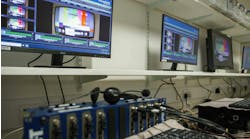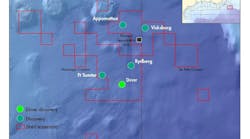Gene Kliewer, Houston
Umbilicals in the news
Petróleo Brasileiro SA (Petrobras) has ordered from Nexans €30 million ($42 million) in umbilicals for the Mexilhão gas field in the Santos basin, off the coast of the state of São Paulo.
The contract calls for two types of umbilical designs to connect the platform to the subsea manifold and the manifold to the subsea wellheads. Delivery is scheduled in 4Q 2008.
The umbilicals are to provide electronic control of seabed systems, and hydraulic and chemical liquid injection. Mexilhão is challenging due HP/HT conditions. The temperatures exceed 130°C (266°F) at the well heads and working pressures reach 10,000 psi (69 MPa).
“Two umbilicals each around 22 km (13.7 mi) in length, will run from platform, at a depth of 170 m (558 ft), to the manifold at 500 m (1,640 ft), which is the control/distribution unit on the seabed. A further seven umbilicals, totaling nearly 15 km (9.3 mi), will then run from the manifold to the seven wellheads,” says Nexans’ project manager, Per Johansen.
First gas from Mexilhão is expected in April 2009.
In the North Sea, Statoil has contracted Aker Kværner to manufacture and supply steel tube umbilical control cables for the Gjøa field. The contract is worth approximately NOK 260 million ($47.7 million). Aker Kværner will deliver about 16 km (10 mi) of dynamic and static umbilicals manufactured and delivered out of Moss, Norway.
The umbilicals will connect the Gjøa semisubmersible platform - currently being built by Aker Kværner - to the Gjøa field’s subsea production system. Additionally, one umbilical will connect the Gjøa field to the nearby Vega field. Aker Kværner Subsea is also supplying all of the steel tube umbilicals for Vega.
Work on the umbilicals will begin immediately and delivery is scheduled for May 2009.
Gjøa oil and gas field was discovered in 1989 off the west coast of Norway. Statoil operates the field development phase. Production is expected in 2010.
Flowline installation
Hydro has awarded Allseas a NOK 200-million ($37-million) contract to install two 16-in. (40.6-cm) flowlines for the Southern Field Development Project. Installation is scheduled for 2Q 2009 in 900 m (2,953 ft) water depth.
Hydro is the development operator. License holders are Norsk Hydro Produksjon AS - 18.0728%, Petoro AS - 36.4750%, A/S Norske Shell - 17.0375%, Statoil ASA - 10.8441%, DONG Norge AS - 10.3420%, and ExxonMobil Exploration and Production Norway AS - 7.2286%.
Back in Brazil, Petrobras has awarded Technip three deepwater pipeline projects valued at $270 million.
One covers EPIC of a rigid flowline from Canapu field in 1,700 m (5,577 ft) water depth in Espirito Santos basin to the FPSOCidade de Vitoria. The 21-km (13-mi) flowline will be the first pipe-in-pipe gas transportation project in Brazil, Technip says. Technip plans to use the Deep Blue for installation starting in 4Q 2007.
The second contract is for engineering and procurement of 37 km (23 mi) of 4-in. and 6-in. (10-cm and 15-cm) flexible flowlines in Mexilhão field. As mentioned above regarding the umbilicals, the flowlines also will be designed to handle the HP/HT.
The last of the projects is four flexible risers for the PDET export system to be installed in 1,300 m (4,265 ft) of water in Campos basin.
All three of these projects will be handled from Technip’s operations and engineering center in Rio de Janeiro. The flexible pipe will be manufactured in Vitoria, Brazil.
World AUV market forecast to exceed 900
More than 900 autonomous underwater vehicles (AUVs) will be required at a cost of $1.8 billion over the next decade is the forecast from Douglas-Westwood Ltd. Of that total requirement, more than 400 have been built to date, according to The AUV Gamechanger Report 2008-2017.
AUV market by vehicle size and user category.
Source: Douglas-Westwood Ltd.
While oil and gas is the smallest area of demand compared with military and research, the applications are critical to many types of operations. However, with the overall demand exceeding the currently available equipment supply, the competition for the vehicles could affect all users.
“In the civil sector, depletion of shallow-water offshore oil and gas reserves of the North Sea and the Gulf of Mexico has forced the oil and gas companies to move into deep waters and into seeking new enabling technologies,” says John Westwood. “AUVs are now in demand for mapping the seabed for deepwater oil installations.”
“The ‘inspection’, ‘work’, and ‘hybrid’ groups to date only have small populations and these are mainly associated with the commercial oil and gas sector where use of AUVs is still a small apart from specific areas such as oil and gas industry deepwater survey,” says Paul Newman, lead researcher on the study.
“AUVs now have the potential to change the game in many areas of underwater operations. Long an area of research, AUVs are beginning to show their abilities as cost-effective tools in applications ranging from deepwater survey for the offshore oil and gas industry to military operations. The growing need for many facets of ocean observation also offers great potential for AUVs not only to enhance the performance of conventional ship-based operations, but also to operate in difficult-to-access areas such as below the arctic ice,” says Westwood.
“AUVs have now become accepted in a number of key tasks where they have been shown to be more cost effective than previous technology - one example is the success of AUVs in deepwater survey and military operations. The impact of such factors on a technology tends to be cumulative, we believe that acceptance will grow and drivers for this process will continue to strengthen.”




